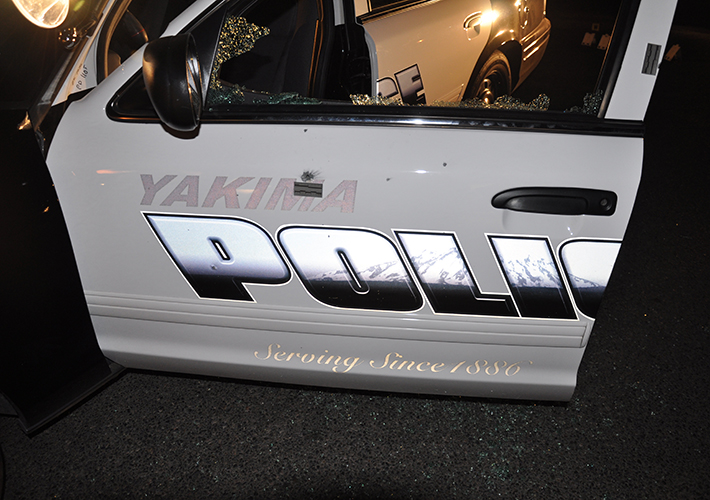
A Standard that Aims to Stop Bullets
Officer Craig Gocha says his life was saved by a ballistic-resistant vehicle door panel on his police car.
In August 2011, after a high-speed chase, a man shot at Gocha – a member of the Yakima Police Department in Washington state – who was still seated in his Crown Victoria. The car’s door served as a shield. While the bullets penetrated the door, they didn’t make it all the way through.
That’s because of the ballistic-resistant panel inside the door, which met the procurement specification created by Officer Richard Kehr of the Los Angeles Police Department.
The LAPD specification was completed in 1995, says Kehr, a member of ASTM International’s committee on homeland security applications (E54). He constantly improved that document through the years, and he tried to make sure all LAPD vehicles were adhering to it. His improvements included considerations for ammunition types, velocities, shot patterns, and the exploitation of potentially weak areas on the doors.
READ MORE: Body Armor Standards
Kehr’s specification has been used by some but not all police departments across the U.S. Yakima P.D., fortunately for Gocha, was one of them.
Ballistic-resistant door panels for police vehicles are increasingly made from a combination of ceramic and fabric. Ceramic functions as what is known as the “strike face,” breaking the bullet, while the fabric then catches the “spalls” or debris.
Chung-Lie Ting formerly was a part owner in BLS Textiles, a company that made door panels that met the LAPD’s procurement specification. “It was the only standard at the time,” he says.
A few years ago, Officer Kehr, asked Ting, who was acting a technical adviser to E54, to join him in efforts to use the LAPD specification as a starting point for a new ASTM International standard.
They got to work, making sure that a variety of voices were heard as the ASTM International standard came together.
For example, Kehr and Officer Nicholas Roberts of the Greater Salt Lake Police Department offered the subcommittee insight into what kinds of guns are out on the streets and how that affects the types of ballistic armor needed for door panels.
Officer input was important, Ting says, because they’re familiar with the types of guns and ammunition criminals use. “Criminals are coming up with new bullets all the time, so you have to catch up with the bad guys out there,” he says.

The door that saved Officer Gocha's life.
The group’s members conducted extensive research. LAPD was involved, along with major U.S. agencies like the National Institute of Standards and Technology and the National Institute of Justice.
One key issue discussed by the task group was panels made from various materials.
Ting says, “You have people claiming, ‘My panel with certain weight can do this or that,’ but if you look closer, their panel might be smaller or provide less coverage. There were no standards manufacturers needed to meet.”
For example, he said, “A panel made from basic armored steel with the same weight as the ceramic-fabric panel will often stop lead-core ammunition, but it often won’t stop bullets that have a certain steel core. Some people have asked, ‘Why do I need a panel to stop an AK-47 ammunition with steel core, or AR-15 M855 or M193 ammunition?’ It’s because that’s what the bad guys use.”
After more than two years of work, in November 2018, the group reached consensus, publishing the “standard specification for ballistic-resistant vehicle door panels used by public safety officers” (E3113).
Technically speaking, the standard lays out “the requirements for ballistic-resistant panels on public safety vehicle doors in order to protect those in the vehicle against complete penetration of projectiles from small arms.” The specification standardizes protection levels and includes language to help police departments (and other public safety agencies) retrofit current vehicles or purchase new vehicles with ballistic-resistant doors.
Most importantly, the E3113 standard defines ballistic tests for vehicle door panels. Such doors need to pass tests for many bullet types, including those with steel cores.
According to Kehr, doors that meet E3113 can now be used as shields when officers crouch behind them during gunfire.
As a result of the new standard, Ting says, there will hopefully be a little less confusion in the marketplace.
“If you have a standard, at least you know what you’re getting. It makes buying a lot easier. With this standard, every requirement is written down, and it’s not specific to a precinct,” he says.
Ting expects the standard to be revised as the bullets and guns change and as manufacturing techniques and bullet-stopping materials evolve.
Jean Thilmany is a freelance writer based in St. Paul, Minnesota. She has written for Mechanical Engineering Magazine, Engineering.com, and other publications.
 SN Home
SN Home Archive
Archive Advertisers
Advertisers Masthead
Masthead RateCard
RateCard Subscribe
Subscribe Email Editor
Email Editor